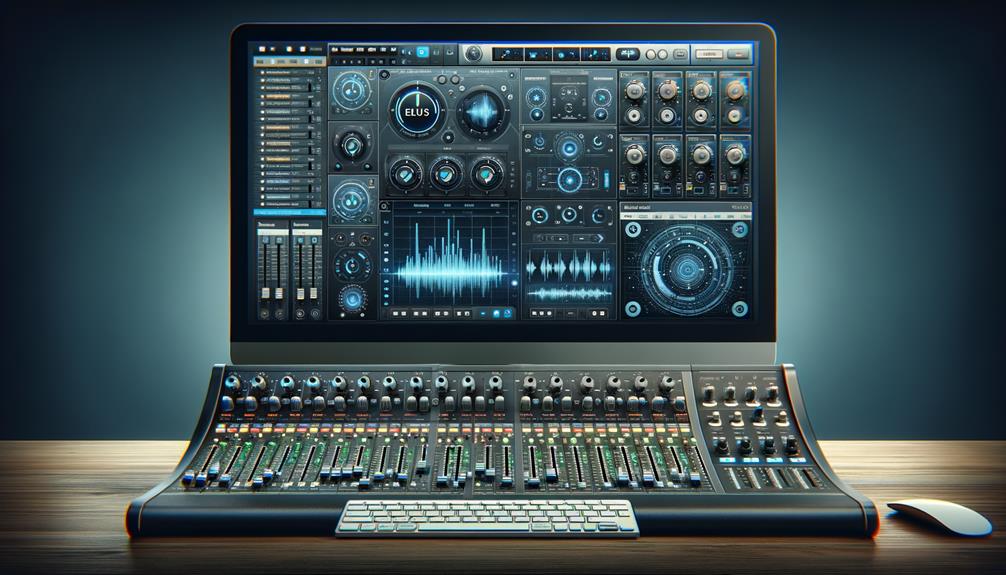To sample in Logic Pro X, follow these three simple steps. First, create a new Software Instrument Track and select “Quick Sampler” to import your audio file. Next, choose your desired playback mode: Classic for sustained notes, One Shot for a complete playback with a single key press, or Slice mode to trigger segments based on transients. Finally, create MIDI regions by dragging your samples into the Tracks area or Live Loops cells, allowing for intricate editing of note length and velocity. With these steps, you’re on your way to crafting unique sounds, while further options await your exploration.
Key Takeaways
- Start by creating a new software instrument track and select “Quick Sampler” for audio file integration.
- Choose the desired playback mode (Classic, One Shot, or Slice) to suit your sampling needs.
- Utilize musical typing or a MIDI keyboard for performance, mapping samples to keys around root key C3.
- Drag your samples into the Tracks area or Live Loops to create MIDI regions for easy arrangement.
- Adjust and polish your samples using EQ techniques to enhance sound quality before finalizing your project.
Adding a Sample
To begin the sampling process in Logic Pro X, first navigate to your project workspace and select “Track,” followed by “New Software Instrument Track.” This action allows you to integrate a sample seamlessly into your project.
The first thing to do is choose “Quick Sampler” from the Instrument slot menu, which facilitates loading your desired audio file. Once selected, click on the Quick Sampler window in the channel strip to access sampling options.
For best results, select the “Optimised” setting, which automatically adjusts tuning, loudness, length, and loop points.
Finally, utilize musical typing or connect a MIDI keyboard to play the sample, ensuring it is mapped to the keys surrounding the root key C3 for efficient performance.
Sample Playback Modes
Understanding the various sample playback modes in Logic Pro X is essential for achieving the desired sonic outcome in your projects.
The Classic mode allows you to hold a key and play the entire sample across the keyboard range, providing a fluid sound experience.
In contrast, One Shot mode triggers the sample to play from start to finish with a single key press, regardless of how long the key is held down.
Slice mode offers a more dynamic approach by dividing the sample into distinct hits based on detected transients, enabling independent playback of each slice.
This functionality is particularly beneficial when creating a Drum Machine Designer track, where you can map each slice to specific keys for enhanced performance flexibility.
Additionally, employing EQ techniques can further refine the sound of your samples, ensuring clarity and separation in your mix.
Editing and Creating MIDI Regions
Creating MIDI regions in Logic Pro X from sliced samples enhances your workflow by enabling precise control over musical elements.
To generate a MIDI region, simply drag your sliced sample into the Tracks area or a Live Loops cell. This action creates an accompanying MIDI region for playback. You can easily duplicate a MIDI pattern via the Action pop-up menu, allowing for multiple instances while preserving the original pitch and timing settings.
Pasted MIDI regions can be repositioned within the Tracks area or Live Loops grid for flexible arrangement. Further customization is achievable in the Piano Roll Editor, where you can edit note length, velocity, and position to refine your composition, ensuring a polished final product. Additionally, utilizing MIDI controller techniques can enhance the organic feel of your beats, adding a personal touch to your productions.
Frequently Asked Questions
How to Sample on Logic X?
To sample in Logic Pro X, explore various sample types and sampling techniques. Utilize audio manipulation for loop creation, and leverage MIDI integration for enhanced creativity, allowing for dynamic arrangements and intricate compositions within your music production workflow.
Where Is the Quick Sampler in Logic Pro X?
The Quick Sampler in Logic Pro X is accessed via “Track” and “New Software Instrument Track.” It offers intuitive features for effective sampling, including tuning, effects, and workflow enhancements, alongside potential alternatives and useful tips for ideal use.
How to Use Sample Pack in Logic?
To effectively use sample packs in Logic, focus on importing sample packs, organizing your samples library, using loops effectively, editing sample audio for precision, and creating custom samples to enhance your projects and streamline your workflow.
Does Logic Pro Have a Built-In Sampler?
Yes, Logic Pro X includes a built-in sampler, Quick Sampler, which offers advanced audio manipulation features. It supports various sampler types for creative sampling and sound design, enhancing users’ ability to craft unique soundscapes.
Conclusion
In summary, sampling in Logic Pro X enhances music production capabilities through a streamlined process. By effectively adding samples, selecting appropriate playback modes, and editing or creating MIDI regions, users can achieve a diverse range of sounds and textures. Mastery of these fundamental steps not only fosters creativity but also reveals the full potential of the software, allowing for intricate compositions and innovative sound design, ultimately contributing to a more dynamic and engaging musical experience.



